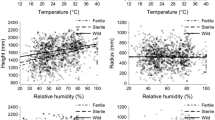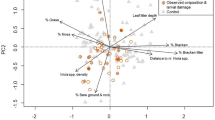Abstract
We performed a series of laboratory experiments to determine the effects of shade, soil moisture, and soil compaction on the selection of pupation habitats by wandering late-instar Oriental fruit flies, Bactrocera dorsalis (Hendel). Larvae showed a strong preference toward pupating in shaded rather than brightly lit areas, in moist rather than dry soil, and in soil with larger particle sizes. These behavioral preferences are likely to lead to clumped distribution of Oriental fruit fly pupae in natural habitats. The implications of this for management of localized populations by chemical and biological methods are discussed.
Similar content being viewed by others
REFERENCES
Analytical Software (1996). Statistix forWindows, Version 1.0, Analytical Software, Tallahassee, FL.
Arai, T. (1975). Diel activity rhythyms in the life history of the Oriental fruit fly. Japan. J. Appl. Entomol. Zool. 19: 253–259.
Arai, T. (1976). Effects of light and temperature on the diel cyclicity of the larval jumping behavior of the Oriental fruit fly, Dacus dorsalis (Hendel). Japan. J. Appl. Entomol. Zool. 20: 69–76.
Christenson, L. C., and Foote, B. H. (1960). Biology of fruit flies. Annu. Rev. Entomol. 5: 171–192.
Conover, W. J., and Iman, R. L. (1981). Rank transformations as a bridge between parametric and nonparametric statistics. Am. Stat. 35: 124–129.
Darby, H. H., and Kapp, E. M. (1934). Studies on the Mexican fruit fly, Anastrepha ludens (Loew). USDA Technical Bulletin No. 444.
Eskafi, F. M., and Fernandez, A. (1990). Larval-pupal mortality of Mediterranean fruit fly (Diptera: Tephritidae) from interaction of soil, moisture, and temperature. Environ. Entomol. 19: 1666–1670.
Fletcher, B. S. (1989). Life history strategies of tephritid fruit flies. In Robinson, A. S., and Hooper, G. (eds.), Fruit Flies: Their Biology, Natural Enemies, and Control, (World crop pests series, Vol. 3B), Elsevier, Amsterdam, pp. 195–208.
Haramoto, F. H., and Bess, H. A. (1970). Recent studies on the abundance of the oriental and Mediterreanean fruit flies and the status of their parasites. Proc. Hawaii. Entomol. Soc. 20: 551–566.
Hennessey, M. K. (1994). Depth of pupation of Carribean fruit fly (Diptera: Tephritidae) in soils in the laboratory. Environ. Entomol. 23: 1119–1123.
Hodgson, P. J., Sivinski, J., Quintero, G., and Aluja, M. (1998). Depth of pupation and survival of fruit fly (Anastrepha spp.: Tephritidae) pupae in a range of agricultural habitats. Environ. Entomol. 27: 1310–1314.
Jackson, C. G., Long, J. P., and Klungness, L. M. (1998). Depth of pupation in four species of fruit flies (Diptera: Tephritidae) in sand with and without moisture. J. Econ. Entomol. 91: 138–142.
Lindegren, J. E., and Vail, P. V. (1986). Susceptibility of Mediterranean fruit fly, melon fly, and Oriental fruit fly (Diptera: Tephritidae) to the entomogenous nematode Steinernema feltiae in laboratory tests. Environ. Entomol. 15: 465–468.
Lindegren, J. E., Wong, T. T., and McInnis, D. O. (1990). Response of Mediterranean fruit fly (Diptera: Tephritidae) to the entomogenous nematode Steinernema feltiae in field tests in Hawaii. Environ. Entomol. 19: 383–386.
Purcell, M. F., and Schroeder, W. J. (1996). Effect of Silwet L-77 and diazinon on three tephritid fruit flies (Diptera: Tephritidae) and associated parasitoids. J. Econ. Entomol. 89: 1566–1570.
Smith, P. H. (1989). Behavioral partitioning of the day and circadian rhythmicity. In Robinson, A. S., and Hooper, G. (eds.), Fruit Flies: Their Biology, Natural Enemies, and Control, Vol. 3B, Elsevier, Amsterdam, pp. 325–341.
Stark, J. D., Vargas, R. I., and Thalman, R. K. (1990). Azadirachtin: Effects on metamorphosis, longevity, and reproduction of three tephritid fruit fly species (Diptera: Tephritidae). J. Econ. Entomol. 83: 2168–2174.
Stark, J.D., Vargas, R. I, Messing, R. H., and Purcell, M. (1992a). Effects of cyromazyne and diazinon on three economically important Hawaiian tephritid fruit flies (Diptera: Tephritidae) and their endoparasitoids (Hymenoptera: Braconidae). J. Econ. Entomol. 85: 1687–1694.
Stark, J. D., Wong, T. T. Y., Vargas, R. I., and Thalman, R. K. (1992b). Survival, longevity, and reproduction of tephritid fruit fly parasitoids (Hymenoptera: Braconidae) reared from fruit flies exposed to azadirachtin. J. Econ. Entomol. 85: 1125–1129.
Thomas, D. B. (1995). Predation on the soil inhabiting stages of the Mexican fruit fly. Southwest. Entomol. 20: 61–71.
Vargas, R. I. (1989). Mass production of tephritid fruit flies. In Robinson, A. S., and Hooper, G. (eds.), Fruit Flies: Their Biology, Natural Enemies, and Control, Vol. 3B, Elsevier, Amsterdam, pp. 141–151.
Vargas, R. I., Miyashita, O., and Nishida, T. (1984). Life history and demographic parameters of three laboratory-reared tephritids (Diptera: Tephritidae). Ann. Entomol. Soc. Am. 77: 651–656.
Vargas, R. I., Chang, H. B., Komura, M., and Kawamoto, D. (1987). Mortality, stadial duration, and weight loss in three species of mass-reared fruit fly pupae (Diptera: Tephritidae) held with and without vermiculite at selected relative humidities. J. Econ. Entomol. 80: 972–974.
White, L. D. (1980). Cherry fruit fly: effects of environmental factors on densities of pupae. Environ. Entomol. 9: 311–314.
Wong, M. A., and Wong, T. T. Y. (1988). Predation of the mediterranean fruit fly and oriental fruit fly (Diptera: Tephritidae) by the fire ant (Hymenoptera: Formicidae) in Hawaii. Proc. Hawaii. Entomol. Soc. 28: 169–177.
Wong, T. T. Y., McInnis, D. O., Nishimoto, J. I., Ota, A. K., and Chang, V. C. S. (1984). Predation of the Mediterranean fruit fly (Diptera: Tephritidae) by the Argentine ant (Hymenoptera: Formicidae) in Hawaii. J. Econ. Entomol. 77: 1454–1458.
Zar, J. H. (1999). Biostatistical Analysis, 4th ed., Prentice Hall, Upper Saddle River, NJ.
Author information
Authors and Affiliations
Corresponding author
Rights and permissions
About this article
Cite this article
Alyokhin, A.V., Mille, C., Messing, R.H. et al. Selection of Pupation Habitats by Oriental Fruit Fly Larvae in the Laboratory. Journal of Insect Behavior 14, 57–67 (2001). https://doi.org/10.1023/A:1007849629409
Issue Date:
DOI: https://doi.org/10.1023/A:1007849629409




